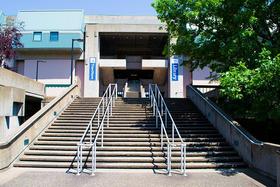- As your community partner in healthcare, Crouse Hospital has been caring for generations of families for more than a century. We offer a full range of general and specialty care, inpatient and outpatient services and community health education and outreach programs.
School Highlights
Pomeroy College of Nursing at Crouse Hospital serves 276 students (20% of students are full-time).
The college's student-teacher ratio of 10:1 is lower than the state community college average of 13:1.
Minority enrollment is 40% of the student body (majority Black), which is less than the state average of 62%.
Quick Facts (2025-26)
- Enrollment: 276 students
- Private-state tuition: $10,287
- Acceptance Rate: 49%
- Student-teacher ratio: 10:1
- Minority enrollment: 40%
- Source: Verified school update
School Overview
The teacher population of 28 teachers has stayed relatively flat over five years.
Pomeroy College of Nursing at Crouse Hospital
(NY) Community College Avg.
Carnegie Classification
Special Focus Two-Year: Health Professions
Baccalaureate/Associate's Colleges: Mixed Baccalaureate/Associate's
Institution Level
At least 2 but less than 4 years
At least 2 but less than 4 years
Institution Control
Private not-for-profit
Private not-for-profit
Total Faculty
28 staff
159 staff
School Calendar
Student Body
The student population of Pomeroy College of Nursing at Crouse Hospital has grown by 27% over five years.
The student-teacher ratio of 10:1 has increased from 9:1 over five years.
The Pomeroy College of Nursing at Crouse Hospital diversity score of 0.60 is less than the state average of 0.76. The school's diversity has stayed relatively flat over five years.
Total Enrollment
276 students
1,129 students
Student-Teacher Ratio
10:1
13:1
# Full-Time Students
55 students
528 students
# Part-Time Students
221 students
601 students
# Enrollment Undergraduate
276 students
357 students
# Full-Time Undergraduate Students
55 students
519 students
# Full-Time Graduate Students
n/a
44 students
# Part-Time Undergraduate Students
221 students
850 students
# Part-Time Graduate Students
n/a
41 students
Total Dormitory Capacity
40 students
382 students
% American Indian/Alaskan
1%
n/a
% Asian
3%
8%
% Hispanic
1%
23%
% Black
9%
18%
% White
60%
38%
% Hawaiian
17%
2%
% Two or more races
7%
3%
% Non Resident races
n/a
3%
% Unknown races
1%
5%
Diversity Score
0.60
0.76
College Completion Rate (Students who graduate in less than 4 years)
64%
33%
College Completion Rate (Students who graduate in 4 years or more than 4 years)
n/a
40%
Average Graduate Earnings (10 Years)
$51,900
$35,200
Tuition and Acceptance Rate
The private state tuition of $16,550 is more than the state average of $16,503. The private state tuition has stayed relatively flat over four years.
Private State Tuition Fees
$10,287
$16,503
% Students Receiving Some Financial Aid
85%
88%
Median Debt for Graduates
$15,250
$13,841
Median Debt for Dropouts
$5,125
$5,500
Acceptance Rate
49%
74%
SAT Reading
461
461
SAT Math
453
488
SAT Writing
n/a
485
ACT Composite
21
21
ACT English
n/a
18
ACT Math
n/a
20
Source: 2024 (or latest year available) Integrated Postsecondary Education Data System (IPEDS) , School Administrators
School Notes
- Crouse Irving Hospital, destined to merge with Syracuse Memorial, was founded by a group of physicians and investors under the leadership of Dr. William L. Wallace in 1912. The building was designed so that if the hospital venture was not successful, the building could be used as a hotel. However, the hospital was needed to care for the growing city population and was efficiently and successfully managed. In 1913, the Crouse Irving Hospital School of Nursing was founded. In June 1996, a new name and updated graphic identity were announced, changing Crouse Irving Memorial Hospital to Crouse Hospital. The Crouse Hospital School of Nursing laboratory is very spacious with a six bed practice area and a self contained classroom. The equipment and supplies are modern and realistic so that students can familiarize themselves with nursing procedures, techniques and equipment. The lab is staffed by clinically expert nursing faculty who offer supportive guidance to the students in a learning environment. All Crouse Hospital nursing students enjoy privileges at the SUNY Upstate Medical University Campus Activities Building, a hub of student recreational activity for the SUNY and Crouse campuses. Facilities include a gym, pool, sauna, exercise equipment, tennis courts, squash courts, pool tables, pinball machines, TV lounge, bookstore and coffee shops Crouse Hospital School of Nursing is registered by the New York State Education Department, which is the administrative arm of the Board of Regents. This Board is recognized by the U.S. Department of Education as a national accrediting body for nursing education programs.
Frequently Asked Questions
How much does Pomeroy College of Nursing at Crouse Hospital cost?
Pomeroy College of Nursing at Crouse Hospital's private state tuition is approximately $10,287.
What is the acceptance rate of Pomeroy College of Nursing at Crouse Hospital?
The acceptance rate of Pomeroy College of Nursing at Crouse Hospital is 49%, which is lower than the state average of 74%.
In what neighborhood is Pomeroy College of Nursing at Crouse Hospital located?
Pomeroy College of Nursing at Crouse Hospital is located in the Eastside neighborhood of East Syracuse, NY.
Recent Articles

How to Transfer from Community College to a Four-Year University in 2025
A step-by-step guide for community college students transferring to a four-year university in 2025 — updated strategies, data and expert insights.

Scholarships for Community College Students 2025
Explore updated scholarship programs, tuition data, and expert strategies for community college students in 2025.

The Rise of Technical and Vocational Training in 2025
Explore the 2025 surge in technical and vocational training—enrollment, policy, costs, and why this path is gaining ground for students and parents.









